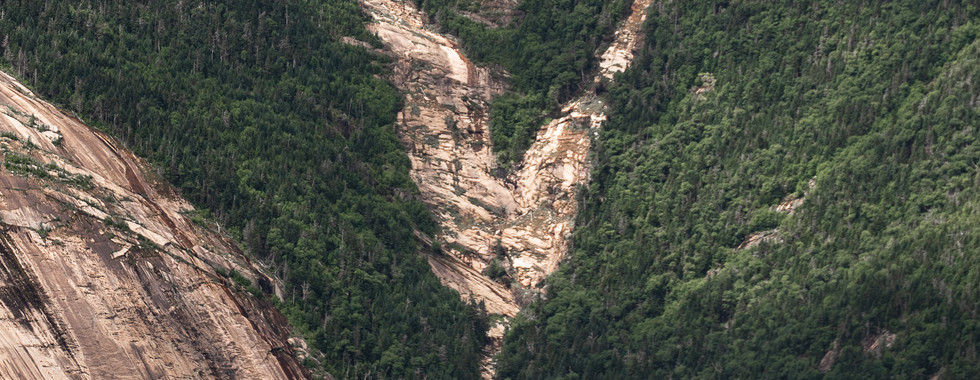Catastrophic Landslides Reshape the Adirondack High Peaks
- Jul 22
- 4 min read

On July 13, 2025, the Adirondack High Peaks witnessed a unexpected natural event. At approximately 5 P.M. local time, an intense downpour unleashed a series of at least 13 documented landslides across multiple the peaks. In the span of roughly an hour, several inches of rain (with local reports of up to 4 inches) fell in a cloudburst over region, saturating the thin mountain soils and triggering slides on steep slopes. An outbreak of this magnitude hasn’t been seen here in over a decade, and does not happen often. Even more astonishing, 6 of the new slides were “reformed” – occurring on old slide scars that let go again, scraping off freshly regrown soil and vegetation to expose new stretches of bare bedrock. The remaining slides tore through previously untouched terrain. This event is truly one for the history books of the Adirondacks. This blog will go into depth of these slides with photos.

What Are “Slides” in the High Peaks?
In the Adirondacks, “slides” are landslides—strips of mountain where rain-soaked soil, rock, and trees give way and "slide" downhill. What remains is a raw streak of exposed bedrock, often bright white anorthosite that gleams when freshly uncovered. These events typically happen on steep slopes where a thin layer of soil rests on smooth rock. Once that layer is saturated, gravity can pull it loose in a sudden, violent cascade.
While slides are common over geologic time, they are rare within a human lifetime. Most are triggered by extreme weather such as cloudbursts or multi-day rain events. Some cut through untouched terrain, but many reawaken old slide paths, stripping away decades of regrowth. That is exactly what happened on July 13, when several old scars slid again, this time with more force and destruction.

In total, roughly 13 new slide scars have been identified from this event. Out of those, six were reactivations of known older slide areas (now scoured down to fresh rock again), and the rest are brand-new slide tracks on the mountains. The destruction is widespread but concentrated in the High Peaks Wilderness. From my conversations with rangers and my own observations, the mountains that saw significant new slides include:
Mount Colden, Gothics, Saddleback, Basin Mountain, Mount Redfield, Little Marcy and
Algonquin Peak

Mount Colden: The Epicenter
No mountain changed more dramatically than Colden. Known for its steep, slide-prone slopes, Colden saw multiple new slides on nearly every side. Two of them were especially severe and have already been given names by the hiking community.
The Jackson Slide, named in honor of DEC Assistant Forest Ranger Brendan Jackson, who passed away unexpectedly in June, tore down the northwest face of Colden into Avalanche Pass. Following a similar path to the 1999 slide caused by Hurricane Floyd, the Jackson Slide completely buried a quarter-mile section of trail under mud, rocks, and broken trees. The Avalanche Pass Trail is now closed.
For many, this is a surreal sight. That trail has long been one of the main corridors connecting the Adirondak Loj to Lake Colden and is part of several popular loop hikes.
On Colden’s northwest face, the "Northwest Passage Slide" formed a brand-new path from near the summit almost to the edge of Lake Colden. It is now likely the largest slide on Colden. This massive swath of white anorthosite stretches nearly a mile long and hundreds of feet wide in places. From Lake Colden, the view is staggering—a highway of exposed bedrock replacing what just days before was thick forest.
Beyond those two, Colden saw several other new or expanded slides. One poured debris onto the Feldspar Brook trail near Lake Arnold, requiring a small bushwhack detour. Colden’s western slopes also show three or four new scars, especially visible from Algonquin. These fresh gray streaks now run through the evergreens like open wounds.

Looking Ahead: A Changed Landscape
As a photographer and guide in the Adirondacks, I’ve spent years learning the lines of these mountains. But nothing prepared me for this visual change. To get these photos, I flew with my good friend and pilot Chris Dydzulis of the Adirondack Flying Service.
It was sobering. There’s grief in seeing forest erased in minutes but also excitement. These mountains are alive. They move, fracture, and heal in ways we don’t always get to see so clearly.
The slides will fade with time. Soil will grow back (over decades). Trails will be cleared or rerouted. But right now, we are witnessing a rare moment in Adirondack history. The land has shifted. And for those of us paying attention, it’s a chance to reflect, document, and respect the wildness that still defines this place.
I’ve put together a side-by-side gallery of the new slides with “before” images where possible. If you want to see the scale of this change for yourself, see the end of this post. And if you’ve never seen the High Peaks from the sky, I recommend Adirondack Flying Service.
As always, if you're heading into the backcountry, check trail conditions and be ready to change your plans. The mountains don’t operate on our schedules. They shift when they’re ready. This event won’t be the last. But it will stand out as one of the most dramatic natural reshaping moments we’ve seen in decades.
SEE GALLERY BELOW










































